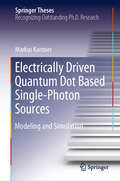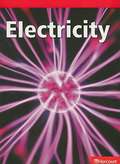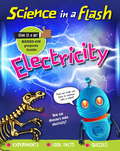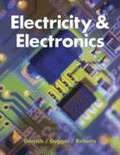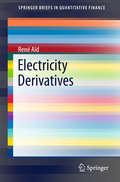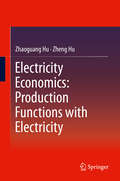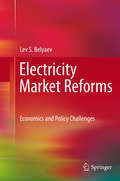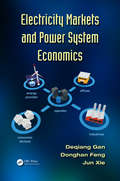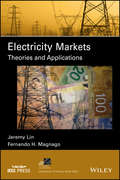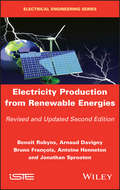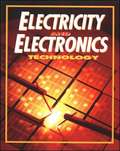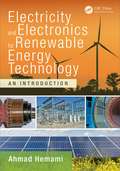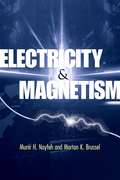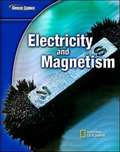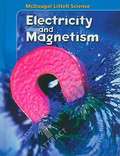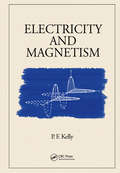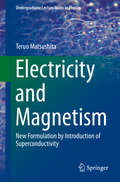- Table View
- List View
Electrically Driven Quantum Dot Based Single-Photon Sources: Modeling and Simulation (Springer Theses)
by Markus KantnerSemiconductor quantum optics is on the verge of moving from the lab to real world applications. When stepping from basic research to new technologies, device engineers will need new simulation tools for the design and optimization of quantum light sources, which combine classical device physics with cavity quantum electrodynamics. This thesis aims to provide a holistic description of single-photon emitting diodes by bridging the gap between microscopic and macroscopic modeling approaches. The central result is a novel hybrid quantum-classical model system that self-consistently couples semi-classical carrier transport theory with open quantum many-body systems. This allows for a comprehensive description of quantum light emitting diodes on multiple scales: It enables the calculation of the quantum optical figures of merit together with the simulation of the spatially resolved current flow in complex, multi-dimensional semiconductor device geometries out of one box. The hybrid system is shown to be consistent with fundamental laws of (non-)equilibrium thermodynamics and is demonstrated by numerical simulations of realistic devices.
Electricity & Electronics
by Richard M. Roberts Howard H. Gerrish William E. Dugger Jr.Textbook on the fundamentals for technical school students. No bibliography.
Electricity (Merit Badge Series)
by Boy Scouts of AmericaThis book introduces scouts to the generation of and uses of electricity.
Electricity (Science in a Flash #23)
by Georgia Amson-BradshawunfortunatelyWhat's the buzz about electricity? All bright sparks need to read this book to discover the shocking facts about electricity, as well as all about batteries, circuits and conductors.This essential KS2 series for children aged 7 and up covers all the key science topics in energetic, quick-fire way, aiding clear comprehension by getting straight to the point! Each spread starts with a 'flash' or headline, summing-up succinctly the science information to follow. Attractive and light-hearted illustration visually conveys the information, adding depth and detail to engage children. Also includes fun jokes and cartoons to keep even the most reluctant readers entertained.
Electricity And Basic Electronics
by Stephen R. MattElectricity and Basic Electronics teaches basic theory and fundamentals and is a starting point for careers in electronics. The text is clearly written and highly illustrated, making it easy for beginners to understand. Numerous examples walk students step-by-step through circuit analysis where applicable. The Practical Application and Project feature covers topics such as breadboarding, soldering, and reading voltage on an oscilloscope. There are 16 practical applications in all. The Project features, 28 in all, allow students to build items such as a continuity tester, blown fuse indicator, and power supply. Projects typically include a schematic, a picture of the finished product, and a procedure for assembling the project. A new Math Focus feature provides students with a quick review of the basic math skills they need to understand the topic at hand. Math topics covered are exponents, scientific notation, metric and electrical prefixes, order of operations, algebraic equations, adding fractions, rations and proportions, and square roots. A new chapter called “Energy Conservation” covers ways to conserve energy and alternative forms of energy. Geothermal systems, photovoltaics, and wind turbines are just some of the topics covered.
Electricity And Electronics
by Richard M. Roberts Howard H. Gerrish William DuggerTextbook on the fundamentals for technical school students. No bibliography.
Electricity Derivatives
by René AïdOffering a concise but complete survey of the common features of the microstructure of electricity markets, this book describes the state of the art in the different proposed electricity price models for pricing derivatives and in the numerical methods used to price and hedge the most prominent derivatives in electricity markets, namely power plants and swings. The mathematical content of the book has intentionally been made light in order to concentrate on the main subject matter, avoiding fastidious computations. Wherever possible, the models are illustrated by diagrams. The book should allow prospective researchers in the field of electricity derivatives to focus on the actual difficulties associated with the subject. It should also offer a brief but exhaustive overview of the latest techniques used by financial engineers in energy utilities and energy trading desks.
Electricity Economics: Production Functions with Electricity
by Zhaoguang Hu Zheng HuElectricity Economics: Production Functions with Electricity studies the production output from analyzing patterns of electricity consumption. Since electricity data can be used to measure scenarios of economic performance due to its accuracy and reliability, it could therefore also be used to help scholars explore new research frontiers that directly and indirectly benefits human society. Our research initially explores a similar pattern to substitute the Cobb-Douglas function with the production function with electricity to track and forecast economic activities. The book systematically introduces the theoretical frameworks and mathematical models of economics from the perspective of electricity consumption. The E-GDP functions are presented for case studies of more than 20 developed and developing countries. These functions also demonstrate substantial similarities between human DNA and production functions with electricity in terms of four major characteristics, namely replication, mutation, uniqueness, and evolution. Furthermore, the book includes extensive data and case studies on the U. S. , China, Japan, etc. It is intended for scientists, engineers, financial professionals, policy makers, consultants, and anyone else with a desire to study electricity economics as well as related applications. Dr. Zhaoguang Hu is the vice president and chief energy specialist at the State Grid Energy Research Institute, China. Zheng Hu is a PhD candidate at the Center for Energy and Environmental Policy, University of Delaware, USA.
Electricity Market Reforms
by Lev S. BelyaevWith the global demand for energy skyrocketing, over the past twenty years many countries have restructured their electric power industries, typically moving from a regulated monopoly to a competitive market structure. The results of these reforms vary significantly from country to country depending on the market organization model and national conditions. This book examines the restructuring in both developed and developing nations, with particular focus on the United States, Great Britain, China, and Russia, and addresses the problems arising from these transitions. The book also contains a comprehensive analysis of different electricity market models and their compatibility with the properties of electric power systems and country conditions. As the most thorough and up to date analysis of the theory and practical experience of electricity deregulation, this book is a must-read for academics, students and researchers with an interest in electric power industry restructuring. It also has direct relevance for engineers, regulators and other decision makers in companies and governmental agencies concerned with energy issues.
Electricity Markets and Power System Economics
by Deqiang Gan Donghan Feng Jun XieAfter the first power plant in history was commissioned for commercial operation by Thomas Edison on Pearl Street in New York in 1882, electricity was sold as a consumer product at market prices. After a period of rapid development, electricity had become such a fundamental product that regulation was believed to be necessary. Since then, the power
Electricity Markets: Theories and Applications (IEEE Press Series on Power Engineering)
by Jeremy Lin Fernando H. MagnagoA comprehensive resource that provides the basic concepts of electric power systems, microeconomics, and optimization techniques Electricity Markets: Theories and Applications offers students and practitioners a clear understanding of the fundamental concepts of the economic theories, particularly microeconomic theories, as well as information on some advanced optimization methods of electricity markets. The authors—noted experts in the field—cover the basic drivers for the transformation of the electricity industry in both the United States and around the world and discuss the fundamentals of power system operation, electricity market design and structures, and electricity market operations. The text also explores advanced topics of power system operations and electricity market design and structure including zonal versus nodal pricing, market performance and market power issues, transmission pricing, and the emerging problems electricity markets face in smart grid and micro-grid environments. The authors also examine system planning under the context of electricity market regime. They explain the new ways to solve problems with the tremendous amount of economic data related to power systems that is now available. This important resource: Introduces fundamental economic concepts necessary to understand the operations and functions of electricity markets Presents basic characteristics of power systems and physical laws governing operation Includes mathematical optimization methods related to electricity markets and their applications to practical market clearing issues Electricity Markets: Theories and Applications is an authoritative text that explores the basic concepts of the economic theories and key information on advanced optimization methods of electricity markets.
Electricity Production from Renewable Energies
by Benoît Robyns Jonathan Sprooten Arnaud Davigny Antoine Henneton Bruno FrançoisSince the early 2000s, energy and environmental issues have led to a marked increase in electricity production from renewable energy sources. Sustainable development and concern for future generations constantly challenge us to develop new technologies for energy production, as well as new energy usage patterns. Their rapid emergence can make these new technologies difficult to understand and can thus affect perceptions.Directed towards a broad audience, this book contributes to a better understanding of new electricity generation technologies. It presents the issues, sources and means of conversion using a general approach, while developing scientific concepts to understand their main technical characteristics.This revised and extended second edition presents current data characterizing the development of these renewable energy sources, covering emerging photovoltaic and tidal technologies, offshore wind power, and recent developments on the integration of these sources into the electricity grid. The emergence of self-production and self-consumption is also addressed. In addition, several exercises provide the reader with an opportunity to evaluate their understanding.
Electricity and Electronics Technology (Seventh Edition)
by McGraw-Hill Book Company Staff Marshall L. Schmitt Charles G. Carter Peter BubanHands-on practice and theory in one introductory text!
Electricity and Electronics for Renewable Energy Technology: An Introduction (Power Electronics and Applications Series)
by Ahmad Hemami<p>Electricity and Electronics for Renewable Energy Technology: An Introduction provides a foundational understanding of electricity and the methods and devices specific to electricity from renewable sources. The book begins with a brief explanation of the necessary mathematics and then: <p> <li>Addresses the basics of electricity and relationships, motors and generators, transformers, and networks and distribution <li>Tackles the key concepts associated with electronics, diodes and transistors, switching devices, and power converters <li>Covers digital electronics from number systems and logic circuits to encoders and decoders <li>Explores advanced subjects such as reactive power and the operation of a transistor</li> <p> <p>A lab manual and PowerPoint presentation are available with qualifying course adoption. <p>Featuring extensive review questions and practice problems at the end of each chapter, Electricity and Electronics for Renewable Energy Technology: An Introduction instills an essential knowledge of electricity and electronics required for work with renewable energy.</p>
Electricity and Electronics for Renewable Energy Technology: An Introduction (Power Electronics and Applications Series)
by Ahmad HemamiElectricity and Electronics for Renewable Energy Technology: An Introduction provides a foundational understanding of electricity and the methods and devices specific to electricity from renewable sources. The book begins with a brief explanation of the necessary mathematics and then: Addresses the basics of electricity and relationships, motors and generators, transformers, and networks and distribution Tackles the key concepts associated with electronics, diodes and transistors, switching devices, and power converters Covers digital electronics from number systems and logic circuits to encoders and decoders Explores advanced subjects such as reactive power and the operation of a transistor A lab manual and PowerPoint presentation are available with qualifying course adoption. Featuring extensive review questions and practice problems at the end of each chapter, Electricity and Electronics for Renewable Energy Technology: An Introduction instills an essential knowledge of electricity and electronics required for work with renewable energy.
Electricity and Magnetism
by Dr Munir H. Nayfeh Dr Morton K. BrusselThis outstanding text for a two-semester course is geared toward physics undergraduates who have completed a basic first-year physics course. The coherent treatment offers several notable features, including 300 detailed examples at various levels of difficulty, a self-contained chapter on vector algebra, and a single chapter devoted to radiation that cites interrelationships between various analysis methods. Starting with chapters on vector analysis and electrostatics, the text covers electrostatic boundary value problems, formal and microscopic theories of dielectric electrostatics and of magnetism and matter, electrostatic energy, steady currents, and induction. Additional topics include magnetic energy, circuits with nonsteady currents, Maxwell's equations, radiation, electromagnetic boundary value problems, and the special theory of relativity. Exercises appear at the end of each chapter and answers to odd-numbered problems are included in one of several helpful appendixes.
Electricity and Magnetism
by Edward M. PurcellFor 50 years, Edward M. Purcell's classic textbook has introduced students to the world of electricity and magnetism. The third edition has been brought up to date and is now in SI units. It features hundreds of new examples, problems and figures and contains discussions of real-life applications. The textbook covers all the standard introductory topics, such as electrostatics, magnetism, circuits, electromagnetic waves and electric and magnetic fields in matter. Taking a non-traditional approach, magnetism is derived as a relativistic effect. Mathematical concepts are introduced in parallel with the physics topics at hand, making the motivations clear. Macroscopic phenomena are derived rigorously from microscopic phenomena. With worked examples, hundreds of illustrations and nearly 600 end-of-chapter problems and exercises, this textbook is ideal for electricity and magnetism courses. Solutions to the exercises are available for instructors at www. cambridge. org/9781107014022.
Electricity and Magnetism
by Glencoe Mcgraw-HillDiscover the Flexibility to Teach Science Your Way!. "Glencoe Science: Electricity and Magnetism," a module in the Glencoe Science 15 book series, provides students with accurate and comprehensive coverage of middle school National Science Education Standards. Concepts are explained in a clear, concise manner, and are integrated with a wide range of hands-on experiences, critical thinking opportunities, real-world applications, and connections to other sciences and to non-science areas of the curriculum. Co-authored by National Geographic, unparalleled graphics reinforce key concepts. A broad array of print and technology resources help differentiate and accommodate all learners. The modular approach allows you to mix and match books to meet your specific curriculum needs.
Electricity and Magnetism
by P.F. KellyThe final volume in a three-part series, Electricity and Magnetism provides a detailed exposition of classical electric and magnetic fields and analyses of linear electric circuits. The book applies the principles of classical mechanics to systematically reveal the laws governing observed electric and magnetic phenomena. The text culminates in Maxw
Electricity and Magnetism
by Teruo MatsushitaThe author introduces the concept that superconductivity can establish a perfect formalism of electricity and magnetism. The correspondence of electric materials that exhibit perfect electrostatic shielding (E=0) in the static condition and superconductors that show perfect diamagnetism (B=0) is given to help readers understand the relationship between electricity and magnetism. Another helpful aspect with the introduction of the superconductivity feature perfect diamagnetism is that the correspondence in the development of the expression of magnetic energy and electric energy is clearly shown. Additionally, the basic mathematical operation and proofs are shown in an appendix, and there is full use of examples and exercises in each chapter with thorough answers.
